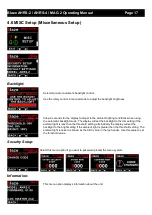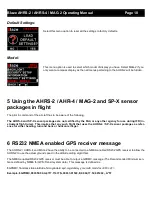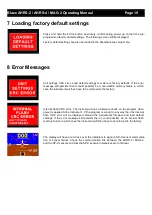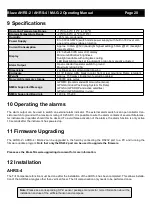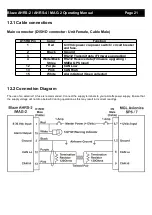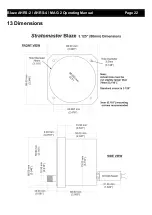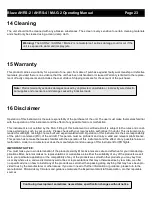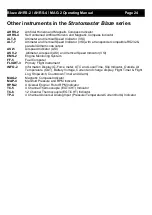
Blaze AHRS-2 / AHRS-4 / MAG-2 Operating Manual
Page 10
Slip:
Select if you would like to enable the slip indicator to be shown underneath the horizon display. The slip indicator oper-
ates in the same fashion as the well known “step on the ball” indicator in traditional cockpits.
Note:
The slip indicator is always enabled in the turn and bank indicator mode.
Slip Sense:
Select if you want the slip to have a high sensitivity or a low sensitivity setting.
Slip Zero:
This function allows you to set your slip indicator to exactly zero even if your aircraft tends to fly slightly wing down. The
procedure is to place the aircraft in a stable, straight and level attitude during calm flight conditions and then select this
function. To cancel the correction, place your sensor absolutely horizontal (use a spirit level) and select the function
again.
Speed Unit:
Select the speed unit.
Speed:
Enter the cruising speed of your aircraft. This speed is transmitted to the attitude sensor for aiding purposes if the GPS
speed is not available.
Pitch Marker:
This enables or disables the pitch markers on the horizon display.
CAN Address:
Select the CAN address of the SP-X attitude sensor.
Pitch Zero:
The pitch zero function must be performed with the AHRS perfectly level. The AHRS will refuse to perform this operation
if the real pitch angle is greater than 10 degrees. Selecting the pitch zero function will zero the pitch, selecting it again will
reset the pitch offset value to 0 degrees.
Bank Zero:
The bank zero function must be performed with the AHRS perfectly level. The AHRS will refuse to perform this operation
if the real bank angle is greater than 10 degrees. Selecting the bank zero function will zero the bank, selecting it again will
reset the bank offset value to 0 degrees.
Couple Coeff (AHRS-4 only):
This is a number from 1 to 10. “1” is the default.
This number determines how “strongly” the AHRS will force the gyro derived horizon estimate to coincide with that of the
accelerometer based level calculations which are based on gravity.
“1” causes a very slow correction. This is the normal state and used most often.
“10” is the highest correction speed. This is usually used if the AHRS is used in unfavorable conditions.
Background:
Gyros can only tell you if you are rotating around any axis (you have three of them). Gyros cannot tell your attitude, they
can only tell you how your attitude is changing.
Accelerometers can tell you your attitude – but only if you are not accelerating. That includes a turn as this involves accel-
eration (constant change of direction). In addition accelerometers will react to any movement of your aircraft caused by
turbulence etc.
So – basically accelerometers can sometimes tell you your attitude while gyros can tell you how your attitude has
changed – but with errors as measurements are never 100% accurate – so the longer you rely only on the gyros the
worse it gets.

















